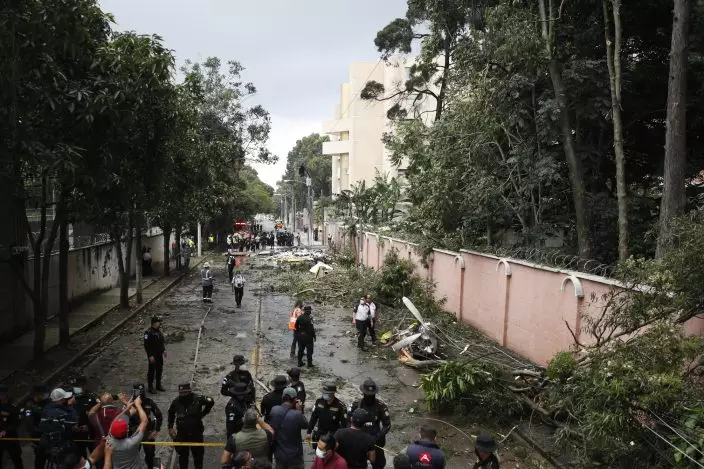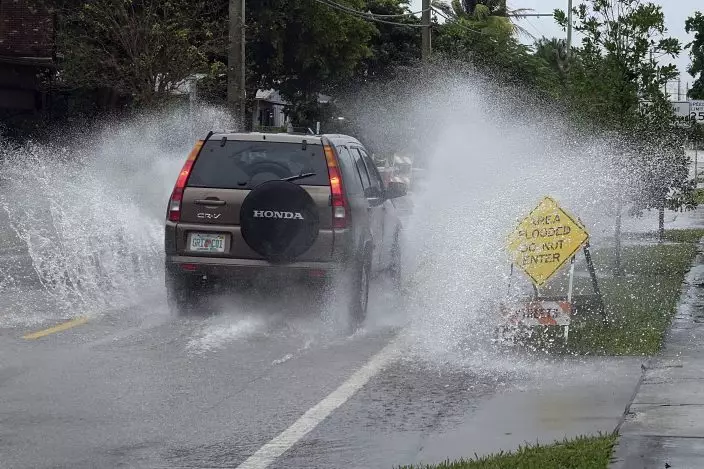Florida closed beaches and COVID testing sites, shut down public transportation and ordered some evacuations Sunday as Tropical Storm Eta took aim, bringing heavy rains to already flooded city streets after leaving scores of dead and over 100 missing in Mexico and Central America.
Eta made landfall late Sunday on Lower Matecumbe Key, Florida. Even if the storm doesn’t strengthen into a hurricane, its slow speed and heavy rains posed an enormous threat to South Florida, an area already drenched from more than 14 inches (0.35 meters) of rain last month. Eta could dump an additional 6 to 12 inches (0.15 to 0.3 meters), forecasters said.
“In some areas, the water isn’t pumping out as fast as it’s coming in,” warned Miami Dade Commissioner Jose “Pepe” Diaz.

A pedestrian walks past a business with sandbags at the ready in case of flooding, Sunday, Nov. 8, 2020, on Miami Beach, Florida's famed South Beach. A strengthening Tropical Storm Eta cut across Cuba on Sunday, and forecasters say it's likely to be a hurricane before hitting the Florida Keys Sunday night or Monday. (AP PhotoWilfredo Lee)
Miami-Dade County Mayor Carlos Gimenez said he was in frequent contact with county water officials about the struggle to drain the flooded waters, which has stalled vehicles, whitewashed some intersections and even crept into some homes.
On Sunday night, authorities in Lauderhill, Florida, responded to a report of a car that had driven into a canal. Photos taken by fire units on the scene about 30 miles (48 kilometers) north of Miami showed rescuers searching high waters near a parking lot.
Firefighters pulled one person from a car and took the patient to a hospital in critical condition, according to a statement from Lauderhill Fire’s public information officer. Responders were continuing to search for others.

Police officers stand guard at the area where a plane that crashed in Guatemala City, Sunday, Nov. 8, 2020. A plane crashed after taking off from Guatemala City's La Aurora Airport with humanitarian aid to the areas affected by the ETA storm. At least one person died in the accident, firefighters reported. (AP PhotoMoises Castillo)
The U.S. National Hurricane Center in Miami declared hurricane and storm surge warnings for the Keys from Ocean Reef to the Dry Tortugas, including Florida Bay.
Eta had maximum sustained winds of 65 mph (100 kph) on Sunday night and was centered about 30 miles (45 kilometers) east-northeast of Marathon, Florida, and 70 miles (115 kilometers) east-northeast of Key West. It was moving west-northwest at 14 mph (22 kph).
In the Florida Keys, the mayor ordered mandatory evacuations for mobile home parks, campgrounds and RV parks and those in low-lying areas. Several schools districts closed, saying the roads were already too flooded and the winds could be too gusty for buses to transport students. Several shelters also opened in Miami and the Florida Keys.

Cars move along a flooded road on Oakland Park, Fla., Sunday, Nov. 8, 2020. A strengthening Tropical Storm Eta sliced across Cuba on Sunday and was aimed at the southern tip of Florida, where officials braced for a storm that could hit at hurricane force after leaving scores of dead and over 100 missing in Mexico and Central America. (Joe CavarettaSouth Florida Sun-Sentinel via AP)
“Please take this storm seriously,” urged Palm Beach County Emergency Management Director Bill Johnson. “Please don’t drive through flooded roadways.”
The storm swelled rivers and flooded coastal zones in Cuba, where 25,000 had been evacuated. But there were no reports of deaths. Authorities in Guatemala on Sunday raised the known death toll there to 27 from 15 and said more than 100 were missing, many of them in the landslide in San Cristobal Verapaz.
At least 20 people also were reported dead in southern Mexico and local officials in Honduras reported 21 dead, though the national disaster agency had confirmed only eight.

A girl rescued from the zone where residents are believed buried by a massive, rain-fueled landslide, is carried on a stretcher to a waiting ambulance during a search and rescue operation, in San Cristobal Verapaz, Saturday, Nov. 7, 2020, in the aftermath of Tropical Storm Eta. (AP PhotoMoises Castillo)
Eta initially hit Nicaragua as a Category 4 hurricane, and authorities from Panama to Mexico were still surveying the damages following days of torrential rains during the week.
In Guatemala, search teams first had to overcome multiple landslides and deep mud just to reach the site where officials have estimated some 150 homes were devastated.
In the worst-hit village, Quejá, at least five bodies have been pulled from the mud. The Indigenous community of about 1,200 residents consisted of simple homes of wood and tin roofs clinging to the mountainside.
Rescue workers used a helicopter to evacuate survivor Emilio Caal, who said he lost as many as 40 family members and relatives. Caal, 65, suffered a dislocated shoulder when the landslide sent rocks, trees and earth hurtling onto the home where he was about to sit down to lunch with his wife and grandchildren. Caal said he was blown several yards (meters) by the force of the slide, and that none of the others were able to get out.
“My wife is dead, my grandchildren are dead,” said Caal from a nearby hospital.
Firefighters’ spokesman Ruben Tellez said at least one additional person died in Guatemala on Sunday when a small plane went down while carrying emergency supplies to the stricken area.
In neighboring Honduras, 68-year-old María Elena Mejía Guadron died when the brown waters of the Chamelecon river poured into San Pedro Sula’s Planeta neighborhood before dawn Thursday.
In southern Mexico, across the border from Guatemala, 20 people died as heavy rains attributed to Eta caused mudslides and swelled streams and rivers, according to Chiapas state civil defense official Elías Morales Rodríguez.
The worst incident in Mexico occurred in the mountain township of Chenalho, where 10 people were swept away by a rain-swollen stream; their bodies were later found downstream.
Flooding in the neighboring state of Tabasco was so bad that President Andrés Manuel López Obrador cut short a trip to western Mexico and was flying to Tabasco, his home state, to oversee relief efforts.
Hurricane Eta’s arrival in northeast Nicaragua Tuesday followed days of drenching rain as it crawled toward shore. Its slow, meandering path north through Honduras pushed rivers over their banks.
Associated Press writers Marlon González in Tegucigalpa, Honduras, contributed to this report.


